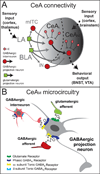The central amygdala as an integrative hub for anxiety and alcohol use disorders
- PMID: 25433901
- PMCID: PMC4398579
- DOI: 10.1016/j.biopsych.2014.09.008
The central amygdala as an integrative hub for anxiety and alcohol use disorders
Abstract
The central amygdala (CeA) plays a central role in physiologic and behavioral responses to fearful stimuli, stressful stimuli, and drug-related stimuli. The CeA receives dense inputs from cortical regions, is the major output region of the amygdala, is primarily GABAergic (inhibitory), and expresses high levels of prostress and antistress peptides. The CeA is also a constituent region of a conceptual macrostructure called the extended amygdala that is recruited during the transition to alcohol dependence. We discuss neurotransmission in the CeA as a potential integrative hub between anxiety disorders and alcohol use disorder, which are commonly co-occurring in humans. Imaging studies in humans and multidisciplinary work in animals collectively suggest that CeA structure and function are altered in individuals with anxiety disorders and alcohol use disorder, the end result of which may be disinhibition of downstream "effector" regions that regulate anxiety-related and alcohol-related behaviors.
Keywords: Anxiety disorder; CRF; Extended amygdala; GABA; NPY; Posttraumatic stress disorder.
Copyright © 2015 Society of Biological Psychiatry. Published by Elsevier Inc. All rights reserved.
Conflict of interest statement
The authors report no biomedical financial interests or potential conflicts of interest.
Figures


References
-
- Cheng DT, Knight DC, Smith CN, Helmstetter FJ. Human amygdala activity during the expression of fear responses. Behav Neurosci. 2006;120:1187–1195. - PubMed
-
- Cheng DT, Knight DC, Smith CN, Stein EA, Helmstetter FJ. Functional MRI of human amygdala activity during Pavlovian fear conditioning: stimulus processing vs response expression. Behav Neurosci. 2003;117:3–10. - PubMed
-
- Semple WE, Goyer PF, McCormick R, Donovan B, Muzic RF, Jr, Rugle L, et al. Higher brain blood flow at amygdala and lower frontal cortex blood flow in PTSD patients with comorbid cocaine and alcohol abuse compared with normals. Psychiatry. 2000;63:65–74. - PubMed
Publication types
MeSH terms
Substances
Grants and funding
- P50 AA006420/AA/NIAAA NIH HHS/United States
- U01 AA013498/AA/NIAAA NIH HHS/United States
- AA023305/AA/NIAAA NIH HHS/United States
- AA015566/AA/NIAAA NIH HHS/United States
- F32 AA020430/AA/NIAAA NIH HHS/United States
- AA006420/AA/NIAAA NIH HHS/United States
- R01 AA023305/AA/NIAAA NIH HHS/United States
- AA013498/AA/NIAAA NIH HHS/United States
- AA021491/AA/NIAAA NIH HHS/United States
- R01 AA017447/AA/NIAAA NIH HHS/United States
- P60 AA006420/AA/NIAAA NIH HHS/United States
- R01 AA015566/AA/NIAAA NIH HHS/United States
- R01 AA021491/AA/NIAAA NIH HHS/United States
- R00 AA018400/AA/NIAAA NIH HHS/United States
- K99 AA018400/AA/NIAAA NIH HHS/United States
- AA020430/AA/NIAAA NIH HHS/United States
- AA017447/AA/NIAAA NIH HHS/United States
- AA018400/AA/NIAAA NIH HHS/United States
- R37 AA017447/AA/NIAAA NIH HHS/United States
LinkOut - more resources
Full Text Sources
Other Literature Sources
Medical
Miscellaneous

